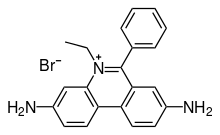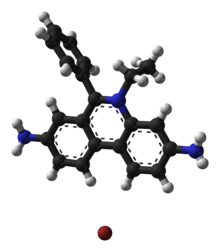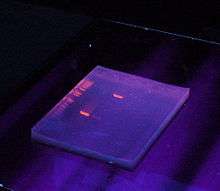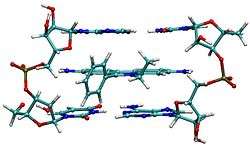Ethidium bromide
Ethidium bromide (also known as homidium bromide[1][2]) is an intercalating agent commonly used as a fluorescent tag (nucleic acid stain) in molecular biology laboratories for techniques such as agarose gel electrophoresis. It is commonly abbreviated as EtBr, which is also an abbreviation for bromoethane. To avoid confusion, some laboratories have used the abbreviation EthBr for this salt. When exposed to ultraviolet light, it will fluoresce with an orange colour, intensifying almost 20-fold after binding to DNA. Under the name homidium, it has been commonly used since the 1950s in veterinary medicine to treat trypanosomiasis in cattle.[3] The high incidence of antimicrobial resistance makes this treatment impractical in some areas, where the related isometamidium chloride is used instead. Ethidium bromide may be a mutagen, although this depends on the organism exposed and the circumstances of exposure.
 | |
 | |
 | |
| Names | |
|---|---|
| IUPAC name
3,8-Diamino-5-ethyl-6-phenylphenanthridinium bromide | |
Other names
| |
| Identifiers | |
3D model (JSmol) |
|
| ChEBI | |
| ChEMBL | |
| ChemSpider | |
| ECHA InfoCard | 100.013.622 |
| EC Number |
|
| KEGG | |
PubChem CID |
|
| RTECS number |
|
| UNII | |
CompTox Dashboard (EPA) |
|
| |
| |
| Properties | |
| C21H20BrN3 | |
| Molar mass | 394.294 g/mol |
| Appearance | Purple-red solid |
| Melting point | 260 to 262 °C (500 to 504 °F; 533 to 535 K) |
| ~40 g/l | |
| Pharmacology | |
| QP51AX06 (WHO) | |
| Hazards | |
| R-phrases (outdated) | R25 R36/37/38 R46 |
| S-phrases (outdated) | S22 S24/25 S26 S36/37/39 S45 S53 |
| NFPA 704 (fire diamond) | |
| Flash point | > 100 °C (212 °F; 373 K) |
Except where otherwise noted, data are given for materials in their standard state (at 25 °C [77 °F], 100 kPa). | |
| Infobox references | |
Structure, chemistry, and fluorescence

As with most fluorescent compounds, ethidium bromide is aromatic. Its core heterocyclic moiety is generically known as a phenanthridine, an isomer of which is the fluorescent dye acridine. Absorption maxima of EtBr in aqueous solution are at 210 nm and 285 nm, which correspond to ultraviolet light. As a result of this excitation, EtBr emits orange light with wavelength 605 nm.[4][5]
Ethidium bromide's intense fluorescence after binding with DNA is probably not due to rigid stabilization of the phenyl moiety, because the phenyl ring has been shown to project outside the intercalated bases. In fact, the phenyl group is found to be almost perpendicular to the plane of the ring system, as it rotates about its single bond to find a position where it will impinge upon the ring system minimally. Instead, the hydrophobic environment found between the base pairs is believed to be responsible. By moving into this hydrophobic environment and away from the solvent, the ethidium cation is forced to shed any water molecules that were associated with it. As water is a highly efficient fluorescence quencher, the removal of these water molecules allows the ethidium to fluoresce.
Applications

Ethidium bromide is commonly used to detect nucleic acids in molecular biology laboratories. In the case of DNA this is usually double-stranded DNA from PCRs, restriction digests, etc. Single-stranded RNA can also be detected, since it usually folds back onto itself and thus provides local base pairing for the dye to intercalate. Detection typically involves a gel containing nucleic acids placed on or under an ultraviolet lamp. Since ultraviolet light is harmful to eyes and skin, gels stained with ethidium bromide are usually viewed indirectly using an enclosed camera, with the fluorescent images recorded as photographs. Where direct viewing is needed, the viewer's eyes and exposed skin should be protected. In the laboratory the intercalating properties have long been used to minimize chromosomal condensation when a culture is exposed to mitotic arresting agents during harvest. The resulting slide preparations permit a higher degree of resolution, and thus more confidence in determining structural integrity of chromosomes upon microscopic analysis.
Ethidium bromide is also used during DNA fragment separation by agarose gel electrophoresis.[6] It is added to running buffer and binds by intercalating between DNA base pairs. When the agarose gel is illuminated using UV light, DNA bands become visible. Intercalation of EtBr can alter properties of the DNA molecule, such as charge, weight, conformation, and flexibility. Since the mobilities of DNA molecules through the agarose gel are measured relative to a molecular weight standard, the effects of EtBr can be critical to determining the sizes of molecules.[7]
Ethidium bromide has also been used extensively to reduce mitochondrial DNA copy number in proliferating cells.[8] The effect of EtBr on mitochondrial DNA is used in veterinary medicine to treat trypanosomiasis in cattle, as EtBr binds molecules of kinetoplastid DNA and changes their conformation to the Z-DNA form. This form inhibits replication of kinetoplastid DNA, which is lethal for trypanosomes.[9]
Alternatives
There are alternatives to ethidium bromide which are advertised as being less dangerous and having better performance.[10][11] For example, several SYBR-based dyes are used by some researchers and there are other emerging stains such as "Novel Juice". SYBR dyes are less mutagenic than EtBr by the Ames test with liver extract.[12] However, SYBR Green I was actually found to be more mutagenic than EtBr to the bacterial cells exposed to UV (which is used to visualize either dye).[13] This may be the case for other "safer" dyes, but while mutagenic and toxicity details are available[14] these have not been published in peer-reviewed journals. The MSDS for SYBR Safe reports an LD50 for rats of over 5 g/kg, which is higher than that of EtBr (1.5 g/kg). Many alternative dyes are suspended in DMSO, which has health implications of its own, including increased skin absorption of organic compounds.[12] Despite the performance advantage of using SYBR dyes instead of EtBr for staining purposes, many researchers still prefer EtBr since it is considerably less expensive.
Health risks

Ethidium bromide is thought to act as a mutagen because it intercalates double-stranded DNA (i.e. inserts itself between the strands), deforming the DNA.[15] This could affect DNA biological processes, like DNA replication and transcription. Ethidium bromide has been shown to be mutagenic to bacteria via the Ames test, but only after treatment with liver homogenate, which simulates the metabolic breakdown of the molecule being tested.[16] The lack of detected mutagenicity without liver homogenate indicates that ethidium bromide is not directly mutagenic, but that its metabolites are; however, the identity of these mutagenic metabolites are unknown. The National Toxicology Program states it is not mutagenic in rats and mice.[17] These conclusions are supported by a subchronic carcinogenicity study in mice, whereby no mutagenic effects were detected.[18] Ethidium bromide (Homidium brand) use in animals to treat trypanosome infection suggests that toxicity and mutagenicity are not high. Studies have been conducted in animals to evaluate EtBr as a potential antitumorigenic chemotherapeutic agent.[19] Its chemotherapeutic use is due to its toxicity to mitochondria.[20] A more recent study shows that EtBr acts as a topoisomerase I poison, just like several anticancer drugs used in humans.[21] The above studies do not support the commonly-held idea that ethidium bromide is a potent mutagen in humans, but they do indicate that it can be toxic at high concentrations. Recent science writers have reported on what is perceived to be disproportionate fear over the toxicity and mutagenicity of the compound.[22][23]
Most use of ethidium bromide in the laboratory (0.25–1 µg/ml) is below the level required for toxicity, and is 3 orders of magnitude lower than the therapeutic dosages used in cattle.[24] The level is high enough that exposure may interfere with replication of mitochondrial DNA in some human cell lines, although the implications of that are not clear. Testing in humans and longer studies in any mammalian system would be required to fully understand the potential risk ethidium bromide poses to lab workers.[25]
Ethidium bromide can be added to YPD media and used as an inhibitor for cell growth.[26]
Handling and disposal
Ethidium bromide is not regulated as hazardous waste at low concentrations,[27] but is treated as hazardous waste by many organizations. Material should be handled according to the material safety data sheet (MSDS).
The disposal of laboratory ethidium bromide remains a controversial subject.[28] Ethidium bromide can be degraded chemically, or collected and incinerated. It is common for ethidium bromide waste below a mandated concentration to be disposed of normally (such as pouring it down a drain). A common practice is to treat ethidium bromide with sodium hypochlorite (bleach) before disposal.[29] According to Lunn and Sansone, chemical degradation using bleach yields compounds which are mutagenic by the Ames test. Data are lacking on the mutagenic effects of degradation products. Lunn and Sansone describe more effective methods for degradation.[30] Elsewhere, ethidium bromide removal from solutions with activated charcoal or ion exchange resin is recommended.[31] Various commercial products are available for this use.[32]
See also
- Phenanthridine
- Agarose gel electrophoresis and gel electrophoresis of nucleic acids
- GelRed (itself derived from ethbr) and GelGreen, marketed as safer and more intense DNA stains
- Propidium iodide and propidium monoazide, related dyes
References
- Homidium
- https://pubchem.ncbi.nlm.nih.gov/compound/Homidium-bromide, accessed 8/9/2020
- Stevenson, P.; Sones, K. R.; Gicheru, M. M.; Mwangi, E. K. (1995). "Comparison of isometamidium chloride and homidium bromide as prophylactic drugs for trypanosomiasis in cattle at Nguruman, Kenya". Acta Tropica. 59 (2): 257–258. doi:10.1016/0001-706X(94)00080-K. PMID 7676909.
- Sabnis, Ram Wasudeo (2010). Handbook of Biological Dyes and Stains: Synthesis and Industrial Application. Hoboken, NJ: Wiley. ISBN 978-0-470-40753-0.
- "Application Note: Ethidium Bromide" (PDF). Retrieved 6 April 2014.
- Borst, P. (Nov 2005). "Ethidium DNA agarose gel electrophoresis: how it started". IUBMB Life. 57 (11): 745–747. doi:10.1080/15216540500380855. PMID 16511967.
- Sigmon, J.; Larcom, L. L. (Oct 1996). "The effect of ethidium bromide on mobility of DNA fragments in agarose gel electrophoresis". Electrophoresis. 17 (10): 1524–1527. doi:10.1002/elps.1150171003. ISSN 0173-0835. PMID 8957173.
- Diaz, F.; Bayona Bafaluy, M. P.; Rana, M.; Mora, M.; Hao, H.; Moraes, C. T. (Nov 2002). "Human mitochondrial DNA with large deletions repopulates organelles faster than full-length genomes under relaxed copy number control". Nucleic Acids Research. 30 (21): 4626–4633. doi:10.1093/nar/gkf602. PMC 135822. PMID 12409452.
- Ullu, E.; Roy Chowdhury, A.; Bakshi, R.; Wang, J.; Yıldırır, G.; Liu, B.; Pappas-Brown, V.; Tolun, G.; Griffith, J. D.; Shapiro, T. A.; Jensen, R. E.; Englund, P. T. (2010). "The Killing of African Trypanosomes by Ethidium Bromide". PLoS Pathogens. 6 (12): e1001226. doi:10.1371/journal.ppat.1001226. ISSN 1553-7374. PMC 3002999. PMID 21187912.
- Huang, Q.; Fu, W. L. (2005). "Comparative analysis of the DNA staining efficiencies of different fluorescent dyes in preparative agarose gel electrophoresis". Clinical Chemistry and Laboratory Medicine. 43 (8): 841–842. doi:10.1515/CCLM.2005.141. PMID 16201894.
- Madden, Dean. "Safer stains for DNA". Retrieved 2009-12-08.
- Singer, V. L.; Lawlor, T. E.; Yue, S. (1999). "Comparison of SYBR Green I nucleic acid gel stain mutagenicity and ethidium bromide mutagenicity in the Salmonella/mammalian microsome reverse mutation assay (Ames test)". Mutation Research. 439 (1): 37–47. doi:10.1016/s1383-5718(98)00172-7. PMID 10029672.
- Ohta, T.; Tokishita, S.; Yamagata, H. (2001). "Ethidium bromide and SYBR Green I enhance the genotoxicity of UV-irradiation and chemical mutagens in E. coli". Mutation Research. 492 (1–2): 91–97. doi:10.1016/S1383-5718(01)00155-3. PMID 11377248.
- "Novel Juice testing report" (PDF). Newmarket Scientific.
- Waring, M. J. (1965). "Complex formation between ethidium bromide and nucleic acids". Journal of Molecular Biology. 13 (1): 269–282. doi:10.1016/S0022-2836(65)80096-1. PMID 5859041.
- McCann, J.; Ames, B. N. (1975). "Detection of carcinogens as mutagens in the Salmonella/microsome test: assay of 300 chemicals". Proceedings of the National Academy of Sciences. 72 (12): 5135–5139. Bibcode:1975PNAS...72.5135M. doi:10.1073/pnas.72.12.5135. PMC 388891. PMID 1061098.
- "Ethidium Bromide: Genetic Toxicity". National Toxicology Program. 2005-08-15. Retrieved 2009-09-30.
- Marossek, V. (2001-12-18). "Identifizierung und Charakterisierung molekularbiologischer Veränderungen am Beispiel des Tumorsuppressors p53 in der Tamoxifen- bzw. Bromdeoxyuridin-induzierten Karzinogenese im Labornager" [Identification and characterization of molecular-biological changes using the example of the tumor suppressant p53 in tamoxifen- or bromodeoxyuridine-induced carcinogenesis in laboratory stock]. Retrieved 2011-09-08.
- Kramer, M. J.; Grunberg, E. (1973). "Effect of Ethidium Bromide against Transplantable Tumors in Mice and Rats". Experimental Chemotherapy. 19 (4): 254–258. doi:10.1159/000221462. PMID 4801160.
- Wurmb-Schwark, N. von; Cavelier, L.; Cortopassi, G. A. (2006). "A low dose of ethidium bromide leads to an increase of total mitochondrial DNA while higher concentrations induce the mtDNA 4997 deletion in a human neuronal cell line". Mutation Research. 596 (1–2): 57–63. doi:10.1016/j.mrfmmm.2005.12.003. PMID 16488450.
- Gentry, A. C.; Juul, S.; Veigaard, C.; Knudsen, B. R.; Osheroff, N. (2011). "The geometry of DNA supercoils modulates the DNA cleavage activity of human topoisomerase I". Nucleic Acids Research. 39 (3): 1014–1022. doi:10.1093/nar/gkq822. PMC 3035449. PMID 20855291.
- April, Derek Lowe 18; 2016 (2016-04-18). "The Myth of Ethidium Bromide". In the Pipeline. Retrieved 2019-02-28.CS1 maint: numeric names: authors list (link)
- Redfield, Rosie. "Heresy about Ethidium Bromide". Retrieved 2019-02-28.
- Oswald, Nick (2007-09-26). "Ethidium Bromide: A Reality Check". Retrieved 2014-05-01.
- National Toxicology Program (2005-08-15). "Executive Summary Ethidium Bromide: Evidence for Possible Carcinogenic Activity" (PDF). Retrieved 2009-09-30.
- Caesar, R.; Warringer, J.; Blomberg, A. (2006). "Physiological importance and identification of novel targets for the N-terminal acetyltransferase NatB". Eukaryotic Cell. 5 (2): 368–78. doi:10.1128/EC.5.2.368-378.2006. PMC 1405896. PMID 16467477.
- "Executive Summary Ethidium Bromide" (PDF). National Toxicology Program. 2005-08-15. Retrieved 2009-09-30.
- Hengen, P. N. (1994). "Methods and Reagents: Disposal of Ethidium Bromide". Trends in Biochemical Sciences. 19 (6): 257–258. doi:10.1016/0968-0004(94)90152-X. PMID 8073504.
- Armour, Margaret-Ann (2003). Hazardous Laboratory Chemicals Disposal Guide (3rd ed.). CRC. pp. 222–223. ISBN 1-56670-567-3.
- Lunn, G.; Sansone, E. B. (1987). "Ethidium bromide: destruction and decontamination of solutions". Analytical Biochemistry. 162 (2): 453–458. doi:10.1016/0003-2697(87)90419-2. PMID 3605608.
- Bensaude, O. (1988). "Ethidium bromide and safety — readers suggest alternative solutions". Trends in Genetics. 4 (4): 89–90. doi:10.1016/0168-9525(88)90092-3. PMID 3238760.
- "Ethidium Bromide Disposal". Archived from the original on 2015-04-15. Retrieved 2006-10-03.
External links

